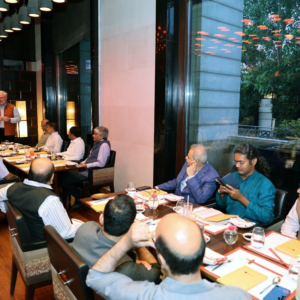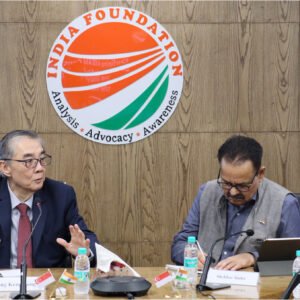China organized it’s first Belt and Road Forum (BRF) Summit in Beijing on 14th-15th May 2017 which was attended by 29 Heads of States and as many as 129 countries including delegation from other South Asian countries, except India and Bhutan. It also included leaders and officials from Russia, US, Japan, UK, Germany and France. The initiative which was proposed in 2013, is the clearest expression of President Xi Jinping’s determination to break away with Deng Xiaoping’s dictum to “hide our capabilities and bide our time”. More recently, China made a robust call in ‘defense of globalization’ at Davos, World Economic Forum (WEF) meet 2017, in same line and vigour.
The ambitious project is backed by top Chinese leadership and draws on the strength of China’s USD 10 trillion economy, with spending of nearly 150 billion USD a year, in the 68 countries that have signed up to the initiative. .Considering the unfolding nature of OBOR project, its opportunities and challenges cannot be set out in clearer terms at present. The project aims to link Asia, Africa and Europe, with an eye to establish free-trade area in the Asia-Pacific region and linking it further to Europe through Land and Maritime Silk Road so as to make it global project whose influence exceeds China’s immediate borders. The ‘grand strategy’ of OBOR looks both to the East and West. Although driving on ‘economic exceptionalism’, it has strategic underpinnings to counter ‘Pivot to Asia’ of United States in the Asia Pacific region and causing shifts in global governance model with new identity and vision. To mention, the initial impression for having multi-model link from Asia to Europe was found in India’s desire for an International North-South Transit Corridor (INSTC), in September 2000, bringing together India, Iran and Russia.
Despite China’s covert objectives to redefine ‘global norms and institutions’ through OBOR project, the idea faces some key challenges at both domestic and global fronts.
Firstly, Beijing expects around USD 100 billion of infrastructure investments in Asia from newly created institutions like AIIB and NDB (BRICS Bank), which seems less likely to realize before 2020. Although AIIB aimed to lend more than USD $1.7 billion in 2016, the amount remains less to the intended projections for OBOR. Secondly, the OBOR project also faces push from different stakeholders in China, considering the involvement of three ministries at the official launch of vision document on OBOR which was released in March 2015. With likely ambition of the project related with provincial interest of Western China, it has chances of being ‘over stretched’ to China’s domestic politics. Thirdly, there is growing tendency for ‘risk aversion’ in China’s financial institutions that forms a key challenge against taking lead in investments abroad.
On the global front, concerns remain on questions of ‘debt repayment’ to China being faced by countries like Ukraine, Zimbabwe, Cambodia and Sri-Lanka. According to IMF report 2016, out of Cambodia’s USD 3.9 billion bilateral public debts with China, 80 percent is owned by China. Further there is also concern on the flow of Chinese goods and services in countries along the Land and maritime route of OBOR. Considering the over capacity of Chinese economy, there are doubts if OBOR aims to link production centers in China to the markets in Eurasia. The project also attaches need to deal with political risk and operational insecurity in Central Asia, South Asia and the Middle East for Chinese investment.
The project also has not found approval from India due to the fact that$46 billion China Pakistan Economic Corridor (CPEC) passes through Pakistan-occupied Kashmir (PoK), with officials declaring that the venture violated Indian sovereignty. The China was unwilling to agree with New Delhi’s requests for consultations on the objectives, nature and financing of the BRI. India has made its position clear that China cannot ignore its concerns on territorial integrity and Chinese will have to adhere to One India policy. As per some reports in media, the likely deployment of 30,000 Chinese ‘security personnel’ to protect the projects along the CPEC, in addition to 15000 troops from Pakistan army make the situation alarming for India. To remember, the standoff on Demchok and Chumar (2014) due to Chinese incursion has drawn concern from India’s highest leadership. India’s future strategy thrust on CPEC must be based on a careful assessment of geopolitics and economics.
Moreover, in the maritime domain China is set to increase number of its marine corps from 20,000 to one lakh at strategic Gwadar port in Pakistan and in military base of Djibouti.. In recent years, China has moved aggressively to increase its power projection capabilities through the rapid modernization of its navy and has increasedits military spending. Given the case of Indian opposition, a ‘meaningful dialogue’ between both is necessary giving due consideration to India’s sovereignty concerns and upholding of ‘One India’ policy. China needs to address the context of rising tension with India in the larger framework of realizing the dream of ‘An Asian Century’.
As the BRF summit concluded major European nations like France, Germany, Estonia, Greece, Portugal and Britain refused to sign the trade document citing concerns on public procurement and environmental standards. The challenge before China is to communicate that its objective and vision for BRI does not represent a threat for regional stability, territorial sovereignty and equitable world order.
(Abhishek Pratap Singh is a Fellow, South Asia Democratic Forum (SADF), Brussels and Doctoral Candidate, Centre for East Asian Studies (Chinese), Jawaharlal Nehru University, New Delhi.)



